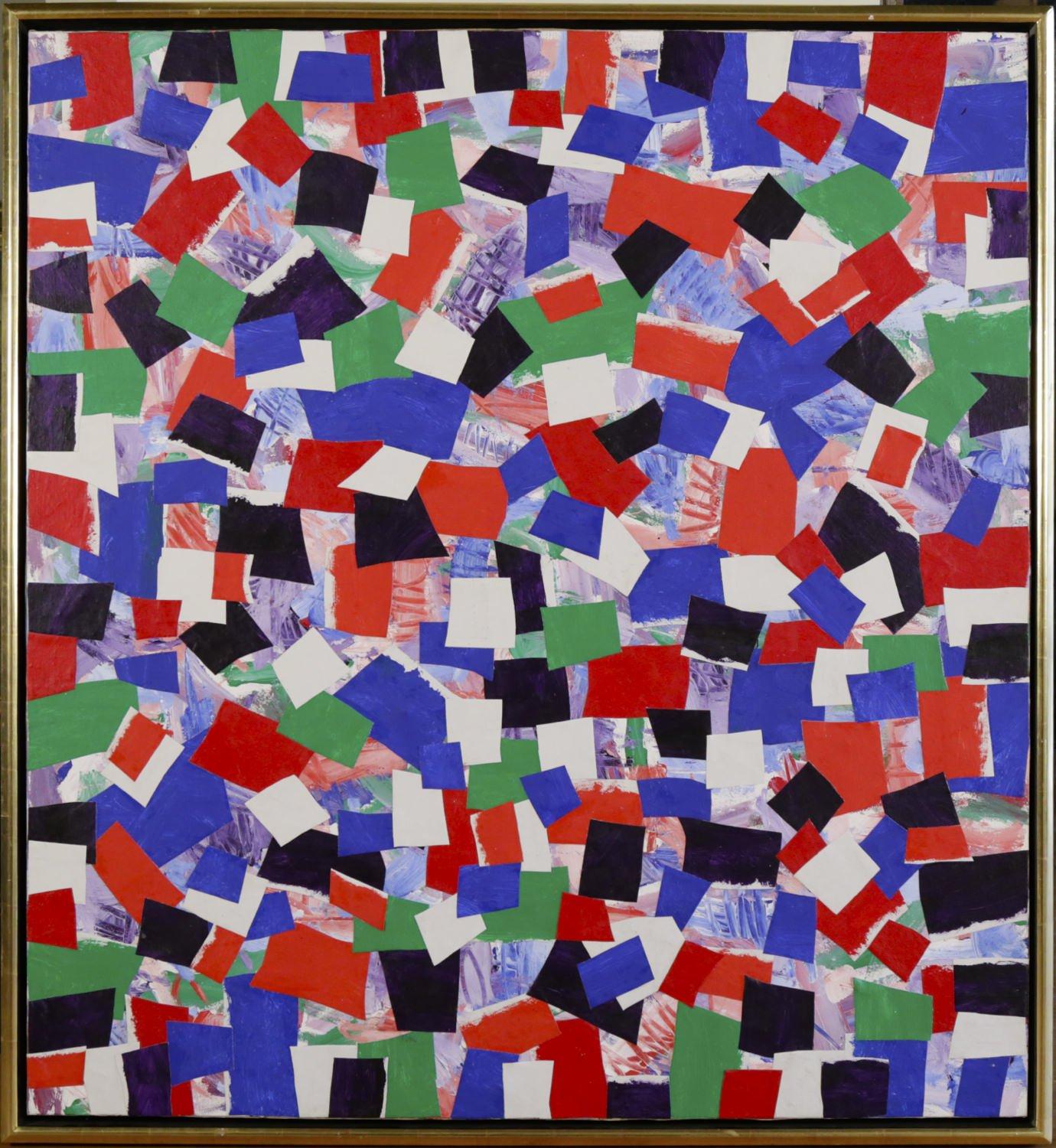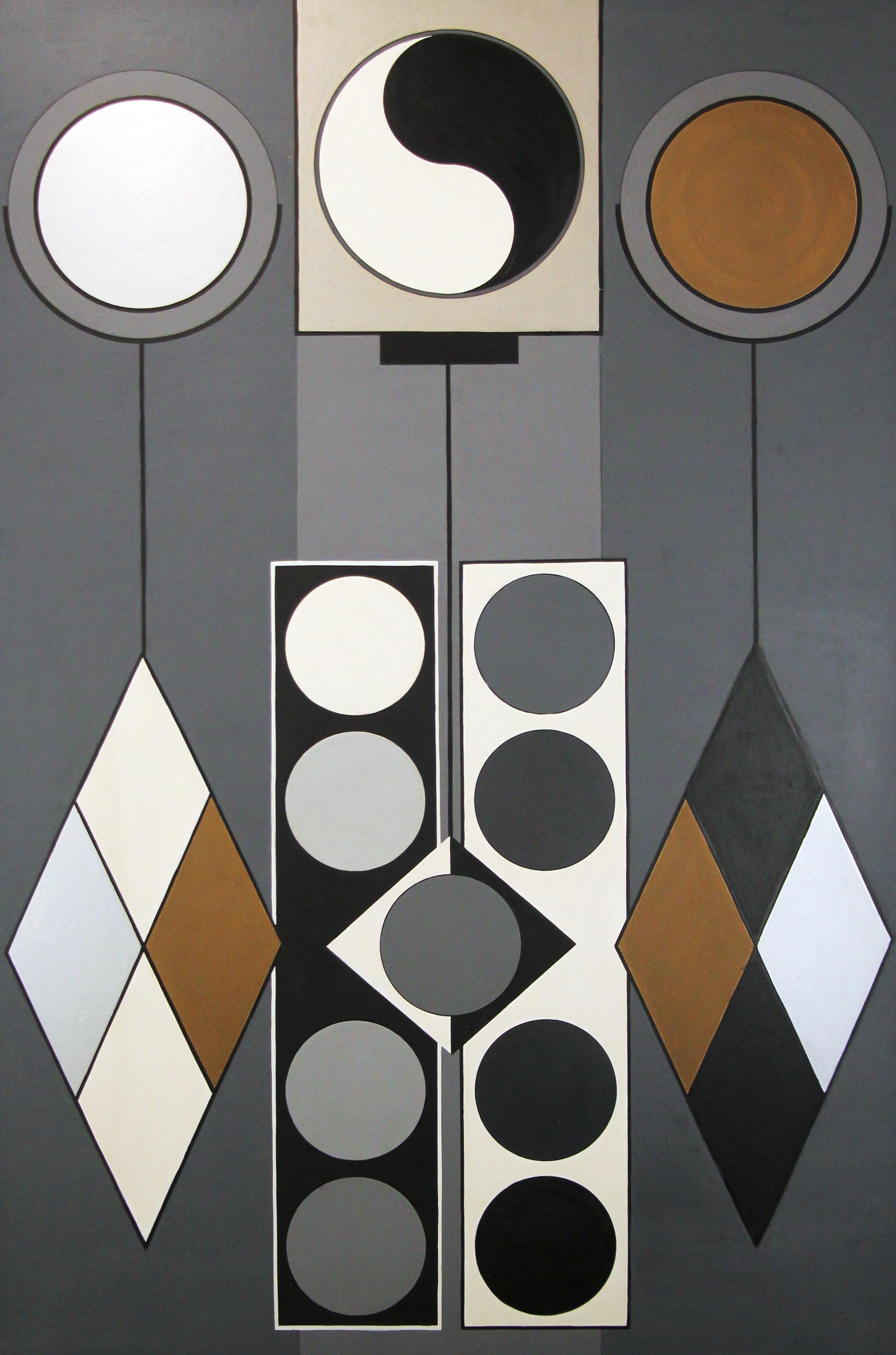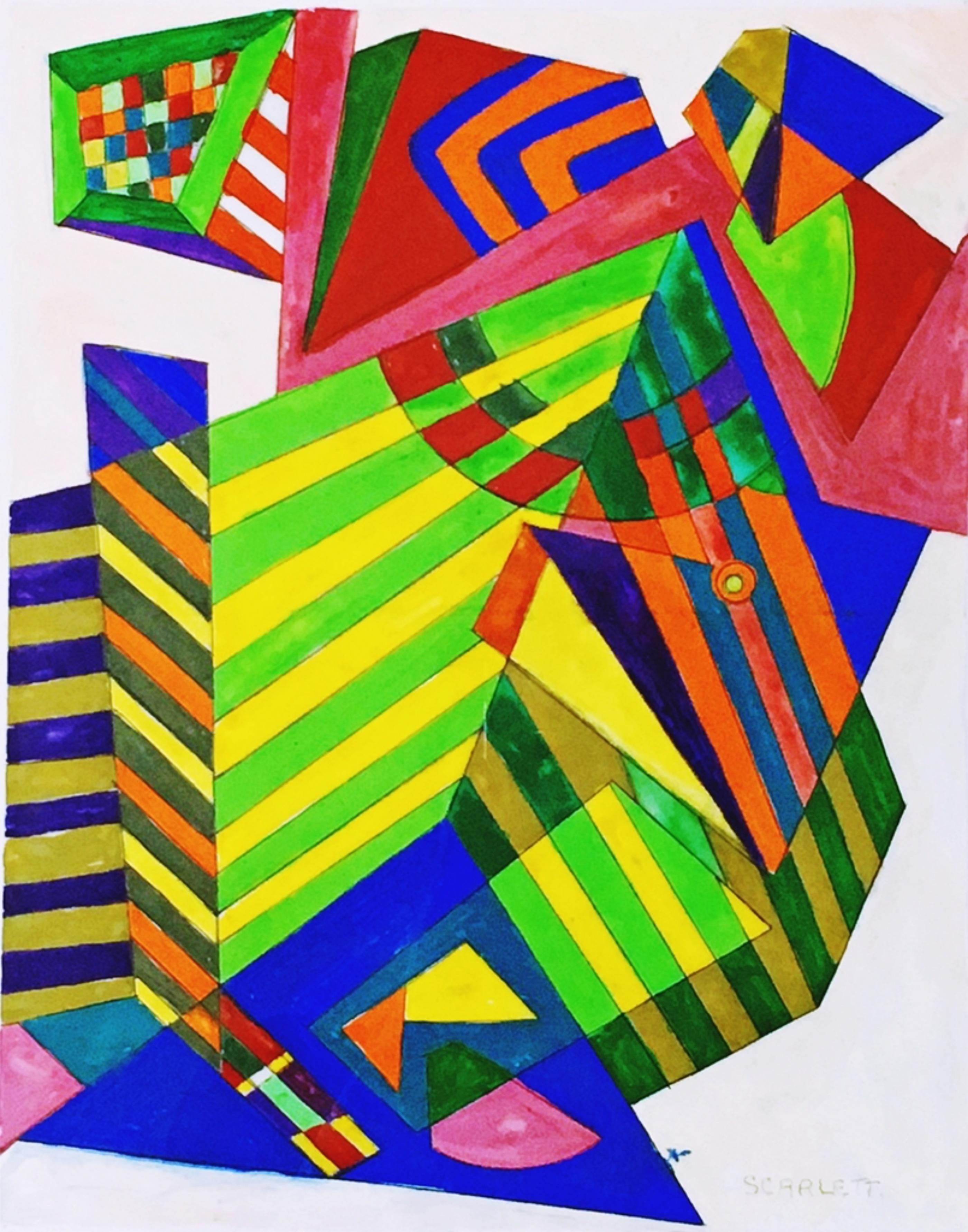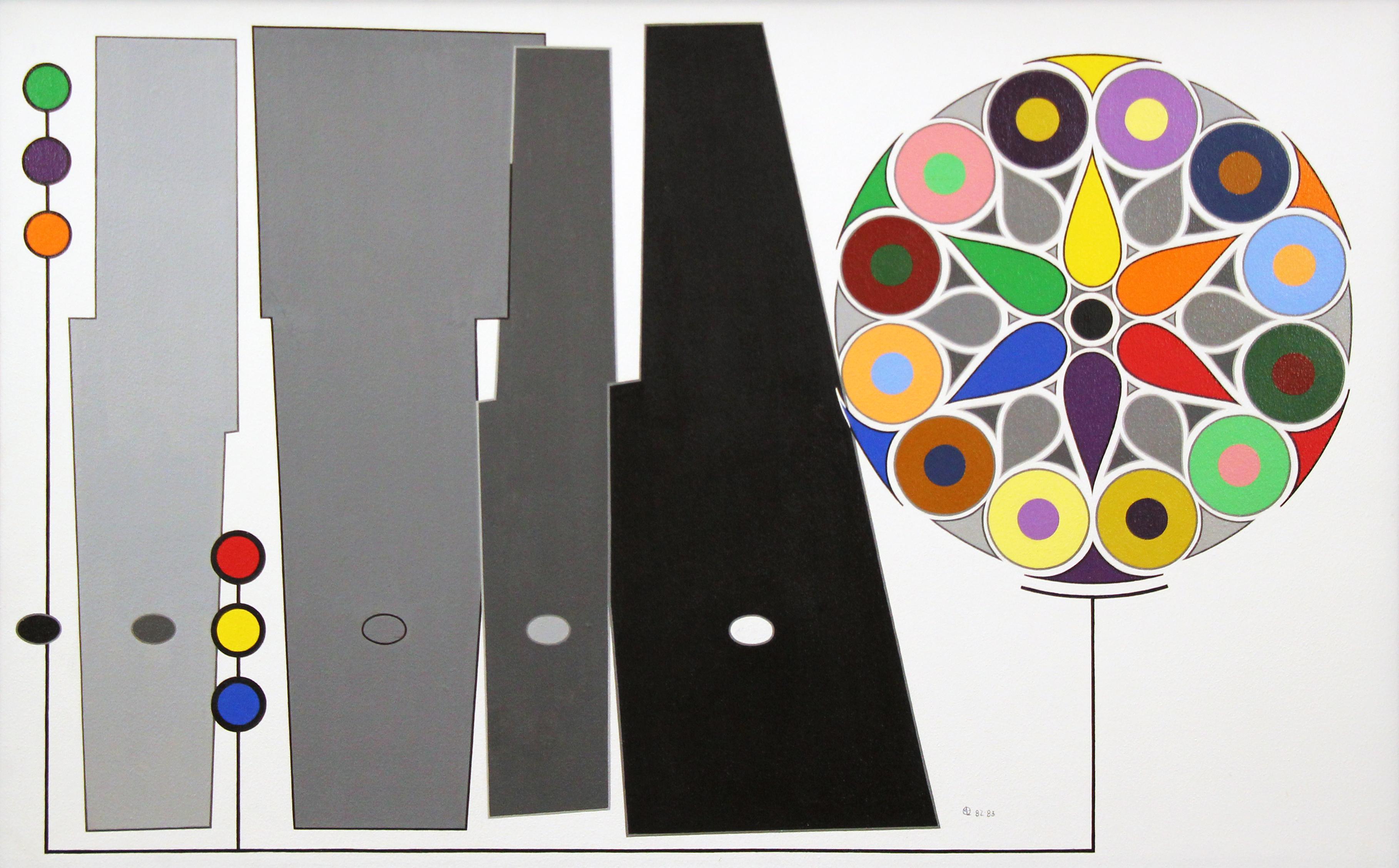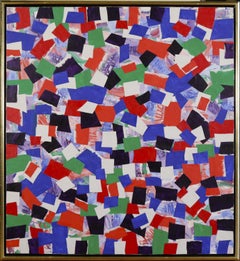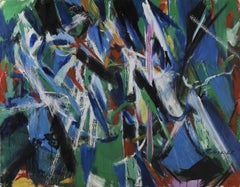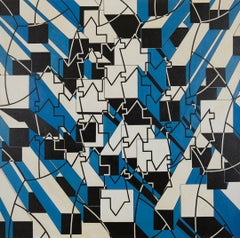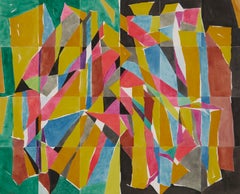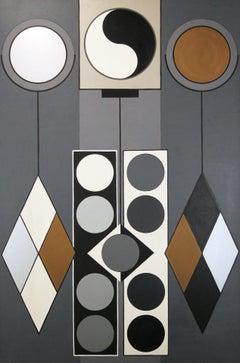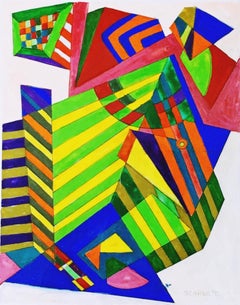Items Similar to Colorful Abstract Geometrical Late 20th Century Painting by Ohio Artist
Video Loading
Want more images or videos?
Request additional images or videos from the seller
1 of 16
James Massena MarchColorful Abstract Geometrical Late 20th Century Painting by Ohio Artist
$1,800
£1,357.38
€1,569.87
CA$2,525.39
A$2,807.13
CHF 1,471.44
MX$34,281.83
NOK 18,370.04
SEK 17,282.78
DKK 11,717.08
About the Item
James Massena March (American, 1953-2021)
Untitled
Oil on canvas
30 x 24 inches
"My paintings are about space, form and energy. I generally start painting without preconceived notions as to the final outcome and build space through a series of constructions and destruction's. The paintings begin with a loose set of limitations and directives. I often work with an abstract idea in mind, several scientific concepts come to mind, to give me focus. I then paint freely, gradually narrowing my focus and zeroing in on a composition that depicts a solid structure, intriguing space and a spontaneity of design. I am interested in complex spatial relationships that lead to a feeling of a comprehensive whole which has energy and a life of it's own. I am also interested in linear movement and visual paradoxes. I do a great deal of my composing on the canvas and never know what I will end up with until I am done. For me painting is an act of discovery." - March
Awards:
Ohio Art Prize for painting- 2009
- Creator:James Massena March (1953 - 2021, American)
- Dimensions:Height: 30 in (76.2 cm)Width: 24 in (60.96 cm)
- Medium:
- Movement & Style:
- Period:
- Condition:
- Gallery Location:Beachwood, OH
- Reference Number:1stDibs: LU1768215794032
About the Seller
5.0
Platinum Seller
Premium sellers with a 4.7+ rating and 24-hour response times
Established in 1975
1stDibs seller since 2022
37 sales on 1stDibs
Typical response time: <1 hour
- ShippingRetrieving quote...Shipping from: Beachwood, OH
- Return Policy
Authenticity Guarantee
In the unlikely event there’s an issue with an item’s authenticity, contact us within 1 year for a full refund. DetailsMoney-Back Guarantee
If your item is not as described, is damaged in transit, or does not arrive, contact us within 7 days for a full refund. Details24-Hour Cancellation
You have a 24-hour grace period in which to reconsider your purchase, with no questions asked.Vetted Professional Sellers
Our world-class sellers must adhere to strict standards for service and quality, maintaining the integrity of our listings.Price-Match Guarantee
If you find that a seller listed the same item for a lower price elsewhere, we’ll match it.Trusted Global Delivery
Our best-in-class carrier network provides specialized shipping options worldwide, including custom delivery.More From This Seller
View AllColorful abstract acrylic collage 20th century painting, New York artist
By Joseph Glasco
Located in Beachwood, OH
Joseph Glasco (American, 1925-1996)
Untitled
1978-81
Acrylic on canvas collage
initialed verso and dated ‘81
48 x 51 inches
Joseph Glasco was born in Paul’s Valley, Oklahoma and gre...
Category
1980s Abstract Expressionist Abstract Paintings
Materials
Acrylic
Large 20th century abstract painting by contemporary Ohio artist, 3.5 x 4.5 feet
Located in Beachwood, OH
James Lepore (American, 1931-2024)
Untitled (Abstract), 1962
Oil on canvas
Signed Lepore 62 lower right
43 x 55 inches
James Lepore was an American artis...
Category
1960s Abstract Abstract Paintings
Materials
Oil
Monumental Blue/White/Black Geometrical Abstract Late 20th Century Painting
Located in Beachwood, OH
James Massena March (American, 1953-2021)
Untitled
Acrylic on canvas
84 x 84 inches
Provenance: From the Estate of James Massena March
"My painti...
Category
Late 20th Century Abstract Geometric Abstract Paintings
Materials
Acrylic
Big Town, Large Colorful Abstract Geometric Painting, Cleveland School Artist
By Kenneth Marcus Hugh
Located in Beachwood, OH
Kenneth Marcus Hugh (American, 1916-2011)
Big Town
Watercolor on paper
Signed lower left
48 in. h. x 60 in. w., image
48.5 in. h. x 60.5 in. w., framed
Kenneth Marcus Hugh was born ...
Category
20th Century Abstract Abstract Drawings and Watercolors
Materials
Watercolor
Magic Garden, vibrant mid-century abstract expressionist colorful geometric work
By Richard Andres
Located in Beachwood, OH
Richard Andres (American, 1927-2013)
Magic Garden, c. 1962
oil on canvas
signed lower left, signed and titled verso
50 x 42 inches
Richard Andres was born in Buffalo, New York in 19...
Category
1960s Abstract Expressionist Abstract Paintings
Materials
Oil
Erie Shore, Large Abstract Expressionist Mid-Century Modern geometric work
By Richard Andres
Located in Beachwood, OH
Richard Andres (American, 1927-2013)
Erie Shore, c. 1975
acrylic on canvas
signed lower right, signed and titled verso
50 x 72 inches
Richard Andres was born in Buffalo, New York in 1927. A graduate of the Cleveland Institute of Art in 1950, he was immediately drafted and served for two years in the army as a mural painter. He received his Master of Arts from Kent State in 1961. A frequent exhibitor at galleries and museums and winner of multiple May Show prizes, Andres taught art in the Cleveland Public Schools for 28 years, as well as teaching the University of Buffalo, the Cleveland Institute of Art and the Western Reserve University.
Very little in Richard Andres’ childhood would have predicted his love of classical music, mid-century-modern architecture and certainly not his lifelong passion for art and in particular abstract art. Richard’s father, Raymond, had no more than a third-grade education, and his mother, Clara, was one of thirteen children – only three of whom lived into adulthood and none of whom attended high school.
They lived, when Richard was a boy, in a dingy area of Buffalo, NY in a walk-up apartment situated above a tavern. Raymond and Clara supplemented the income from their factory jobs in the bar downstairs with Raymond playing ragtime on the piano and Clara serving drinks. This often left Richard and his two older brothers at home alone to fend for themselves. The two older boys, Raymond and Russell, were - unlike Richard- rather rough and tumble and entertained themselves with stickball, boxing and the like. Richard, on the other hand, from a very young age liked to draw, or better yet even, to paint with the small set of watercolors he received for Christmas one year. Paper, however, at the height of the depression, was hard to come by. Luckily, Clara used paper doilies as decoration for the apartment and Richard would contentedly paint and then cut up doilies, gluing the pieces together to create collages.
At eight-years-old, he discovered the Albright-Knox Museum (then known as the Albright Art Gallery) and spent several hours a week there studying the paintings. He was particularly fond of Charles Burchfield‘s landscapes, enamored with their ‘messiness’ and thinking that they somehow captured more ‘feeling’ than works he was previously familiar with. For his tenth Christmas, he asked for and received a ‘how-to’ paint book by Elliot O’Hare. Through this self-teaching, he assembled the portfolio needed for acceptance to Buffalo Technical High School where he studied Advertising Arts. In his Junior year, he was encouraged to enter a watercolor painting, “Two Barns,” in the national 1944-45 Ingersoll Art Award Contest and was one of twelve grand prize winners – each one winning one hundred dollars. More importantly the painting was exhibited at the Carnegie Institute Galleries, which resulted in his winning a national scholarship to the Cleveland School of Art (The Cleveland Art Institute).
He flourished at the art school under the tutelage of faculty members such as Carl Gaertner, as well as that of visiting artists such as William Sommer and Henry George Keller. He would say in later years that Gaertner, in particular, influenced his attitude toward life as well as art. “Gaertner,” Andres said, “believed that there was no need to be a ‘tortured artist’, that an artist should rather enjoy beauty, family, and life in general.” Free to spend his days as he chose, he wandered the Cleveland Art Museum for most of the hours he was not attending classes or painting; the remaining time was spent drinking coffee at a local hangout with art school friends – which is where he met fellow Henry Keller scholarship winner, Avis Johnson. Richard was immediately smitten with Avis, but being rather shy, it took him the entire summer of 1948 to build up his courage to ask her out. Over that summer he ‘thought about Avis’ and worked in a diner to save money. He also used the hundred-dollar prize money won in High School to visit the first Max Beckmann retrospective in the United States at the City Art Museum in St. Louis. Over a half century later he spoke of that exhibit with a reverence usually reserved for spiritual matters, “I walked in and it was like nothing I had ever seen before... the color...It just glowed.”
Returning to campus in the Fall, the first thing he did was go to the coffee shop in hopes of finding Avis. He did, and she, upon seeing him, realized that she was also smitten with him. They quickly became known as ‘the couple’ on campus, and a year later, with Richard being drafted for the Korean war, they were quickly married by a Justice of the Peace, celebrating after with family at Avis’s Cleveland home. As a gift, faculty member John Paul Miller...
Category
1970s Abstract Expressionist Abstract Paintings
Materials
Acrylic
You May Also Like
Colorful Abstract painting by Arnold Weber 1968
By Arnold Weber
Located in Long Island City, NY
Artist: Arnold Weber, American (1931 - 2010)
Title: Colorful Abstract
Year: 1968
Medium: Oil on Canvas, Signed, titled and dated l.l.
Size: 32 x 44 in. (81.28 x 111.76 cm)
Category
1960s Abstract Geometric Abstract Paintings
Materials
Oil
Geometric Flower, Abstract Acrylic Painting on Paper by Jules Engel
By Jules Engel
Located in Long Island City, NY
Artist: Jules Engel, Hungarian/American (1909 - 2003)
Title: Untitled 3
Year: circa 1970
Medium: Acrylic on Paper
Size: 21 x 21 inches
Category
1970s Abstract Geometric Abstract Prints
Materials
Paper, Acrylic
Geometric Abstract #3, multi colored, Philadelphia artist
By Morris Lewis Blackman
Located in Doylestown, PA
"Geometric Abstract #3" is a 59.5 x 40 inches oil on board work by Philadelphia artist Morris Lewis Blackman. The painting is estate stamped on v...
Category
1980s Abstract Abstract Paintings
Materials
Oil, Board
Untitled Mid-Century Modern Geometric Abstraction
By Rolph Scarlett
Located in New York, NY
Rolph Scarlett
Untitled Mid-Century Modern Geometric Abstraction, ca. 1950
Gouache on paper painting
Hand signed on lower right front
This is a stunning original, signed vintage 1950...
Category
Mid-20th Century Abstract Geometric Abstract Paintings
Materials
Gouache, Mixed Media, Pencil
Geometric Abstract #2, multi colored, Philadelphia artist
By Morris Lewis Blackman
Located in Doylestown, PA
"Geometric Abstract #2" is a 30 x 48 inches oil on board work by Philadelphia artist Morris Lewis Blackman. The painting is signed and dated "MLB...
Category
1980s Abstract Abstract Paintings
Materials
Oil, Board
Contest 4
By Charles Miesmer
Located in Fairfield, CT
Miesmer began painting in the open air during the summers in Nantucket. Using a pad of Arches paper as an easel and working out of the back of his pickup truck, the quietude and pea...
Category
21st Century and Contemporary Abstract Geometric Abstract Paintings
Materials
Acrylic, Canvas
